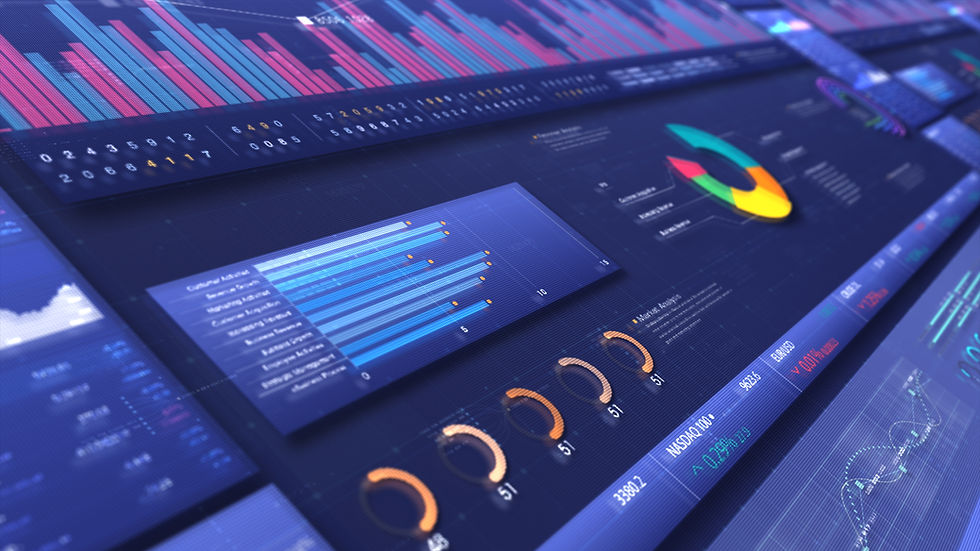10 Ways Big Data and Business Intelligence are Revolutionizing Data Analysis
- Keneisha Salmon-Graham

- Feb 20
- 3 min read
In today's world, data is often referred to as the "new oil." Businesses are increasingly leveraging Big Data and Business Intelligence (BI) to unlock its full potential. While many know about the basic applications, fewer understand the innovative techniques reshaping how organizations analyze and utilize data.
This post explores ten lesser-known ways Big Data and Business Intelligence are changing the game for data analysis, helping companies make better decisions.
1. Predictive Analytics for Proactive Decision-Making
Predictive analytics uses historical data to forecast future trends. For example, retailers can analyze past purchasing patterns to predict what products will be in demand during the holiday season. According to McKinsey, predictive analytics can lead to a 20% increase in sales when used effectively, allowing businesses to adapt their strategies before significant shifts occur.
2. Real-Time Data Processing
The days of delayed data analysis are over. Thanks to advancements in technology, organizations can now analyze data as it flows in. This allows them to make immediate adjustments, such as modifying marketing campaigns in response to real-time customer interactions. Research by Gartner shows that businesses using real-time analytics improve their operational efficiencies by as much as 25%.
3. Enhanced Customer Segmentation
Big Data is enabling businesses to refine customer segmentation like never before. Companies analyze vast datasets to identify niche markets and customize their offerings. For instance, Spotify uses listening data to create personalized playlists for users, significantly increasing user engagement. According to a study by Netflix, targeted recommendations improve user retention by 75%.
4. Machine Learning for Intelligent Insights
Machine learning algorithms play a crucial role in identifying patterns within large datasets. For example, Amazon uses machine learning to suggest products based on previous user behavior and demographics, increasing sales by approximately 35%. This not only improves customer satisfaction but also enhances operational efficiencies across sectors.
5. Data Visualization for Enhanced Understanding
As data complexity increases, effective data visualization has become essential. Visual tools convert raw data into clear, easy-to-understand formats, such as graphs and dashboards. These tools help decision-makers quickly identify trends and outliers. Companies that incorporate data visualization see a 28% improvement in decision-making speed, according to Visier.

6. Integration of IoT Data
The Internet of Things (IoT) produces immense data that enhances business intelligence. For instance, smart thermostats monitor and upload user preferences to optimize energy consumption. Businesses that integrate IoT data report a 20% increase in operational efficiency. By leveraging this data, organizations gain insights that improve customer satisfaction and streamline processes.
7. Natural Language Processing (NLP)
Natural Language Processing is changing how businesses interact with their data. By analyzing unstructured data sources, like customer reviews and social media, businesses can assess customer sentiment. For example, companies that implement NLP can determine product strengths and weaknesses, leading to more informed product development strategies. This has been shown to enhance the customer experience significantly.
8. Cloud-Based Data Solutions
The rise of cloud computing has made managing and analyzing large datasets easier and more cost-effective. Cloud solutions allow businesses, including small startups, to access the same data analysis capabilities as large corporations. This democratization of data analytics has enabled small businesses to compete effectively, leading to increased market diversity.
9. Gamification of Data Analysis
Incorporating game-like elements into data analysis can boost employee engagement. For instance, organizations can create challenges that encourage staff to analyze data, promoting a culture of data-driven decisions. Research shows that gamification can lead to a 30% increase in employee engagement, making analytics a more enjoyable and productive process.
10. Ethical Data Use and Governance
With the growing complexities of data collection, ethical considerations are essential. Companies must prioritize responsible data governance, including fair data collection and protection against breaches. Businesses that commit to ethical data practices often enjoy a 25% increase in customer trust and loyalty, leading to long-lasting relationships.

Final Thoughts
The data analysis landscape is rapidly evolving, driven by advances in Big Data and Business Intelligence. By embracing tools like predictive analytics and real-time processing, organizations can better navigate the complexities of modern data. These methods empower businesses to make informed decisions and cultivate a strong data-driven culture.
Harnessing the power of Big Data is now achievable for businesses of all sizes. With the right tools and ethical practices in place, any organization can leverage data to transform its analysis approach effectively.
.png)
Comments